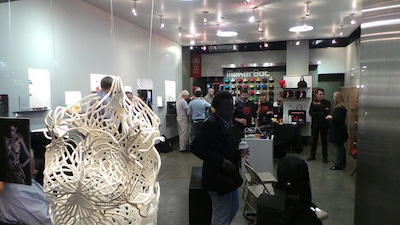True confessions: An engineer explains why he will never buy a 3D printer
May 23, 2016

I have to confess: I am a geek. Not one of those geeks who are into computers and game theory. I am one of those geeks who likes to build things.
I’ve been building things for as long as I can remember. It started with Lego blocks and Lincoln Logs, and then morphed into Erector sets and model cars. I later earned a degree in aerospace engineering, and then started working on bigger things—like airplanes.
Today I work on even bigger things, but in a slightly different way. I own a consulting company called Art of Mass Production in San Diego, CA. We help companies get new products into production. We mostly work on small stuff—power tools, consumer products, handheld medical devices and so forth—but in a big way (and by big, I am referring to the size of the production run). I also write and teach about plastics and design.
|
Image of Makerbot store courtesy |
Like many geeks, I sometimes have a difficult time in social situations, especially when it comes to making small talk. Invariably, someone is going to ask me the question: “So, what do you do for a living?”
I have practiced the response to that question on many levels, and while I think I sometimes get the answer right, I usually brace myself for the response. It typically ranges from something between, “Oh, that’s nice,” and, “What do you think about this new app for the iPad?”
Recently, though, the responses have taken a different tack. Something to the effect of: “You build things? That’s so cool. Have you heard about this new technology? It’s called 3D printing. It is amazing!”
I cringe when I hear this. Yes, I have heard about this technology. Truth be told, I have been using it for more than 25 years. I have been using it almost as long as I have been using 3D CAD software. In fact, I was first introduced to 3D printing shortly after I attended the first-ever meeting of the Pro/Engineer user group in 1990, in Waltham, MA. Turns out DuPont, my employer at the time, had helped develop a technology called stereolithography (SLA). It was in a different division, but through some connections I was able to get some SLA prototypes made for some of the projects I was working on.
Hey, have you heard about this new engineering software? It’s called computer-aided design. You can actually design something in 3D—on a computer! It is amazing!
Sorry, I got distracted. Back to 3D printing.
Yes, 3D printing is amazing. And it’s cool. You can make things using 3D printing that you can’t make any other way—or at least not easily—and it’s fast, precise and affordable. The basic premise is that you create a design in 3D on a computer (using this technology called computer aided-design. Have you heard of it?), then create a file, send it to a 3D printer and have your design printed in 3D.
But 3D printing is not new. While the technology has evolved a lot in the last 25 years, there are some basic constraints, including what materials can be used, and how large—and how precisely—something can be printed. Back then, you had the choice of a couple of different photopolymers, which were cured into a solid layer-by-layer using UV light. Today, a wide range of materials can be used, including not just photopolymers, but other plastics, metals, concrete, even living human tissue.
Another basic constraint is cost—including the cost of the equipment, the raw materials and the time involved. On one hand, the equipment cost for a simple machine has come down, way down, to the point of being a consumer or hobbyist device. Of course, these low-cost machines are not as precise as a high-end machine, and they can’t always do everything you want. Which brings me to an important topic—the value of time.
As I mentioned, I help companies build new products. To do this, we make prototypes, lots of prototypes. And we make breadboards, and fixtures and desktop mock-ups of sub-systems and components. Sometimes we build these prototypes in house, but more often than not, we contract with a prototype machinist to build them for us.
Don’t get me wrong, I’d love to have a machine shop with my own Bridgeport mill, preferably one with CNC control, that can be set up for making not just plunge cuts, but for boring, milling and reaming, as well. I’d also love to have a Hardinge lathe (or better yet a Monarch), capable of holding tolerances of tens of thousands of an inch on small and large diameters so that I can build high-precision cylindrical parts in any kind of material whenever I want.
But the truth is, I don’t have the time. More importantly, I don’t have the knowledge or the skill. I don’t know how to operate these machines—hell, I don’t even know how to change the oil in my car. What I am good at is thinking in three dimensions—and in negative three dimensions. And what I am really, really good at is designing products for mass production. I know how to design parts for injection molding, and I know plastic materials inside and out (I even wrote a book about that). The bottom line: I’m a race car driver, not a mechanic, and I am certainly not a machinist.
A good machinist can make parts and fixtures faster and better than I ever could. The same thing is true when it comes to 3D printing. Sure, I could buy a low-cost 3D printer and print something reasonably close to what I want. But I have to set up the machine, and tinker and putz and experiment to get all the settings right, and then after I am done, I still have to clean everything up. And, if my parts don’t come out right, I have to do it all over again.
So, instead, I call my buddy Derrick at Scicon Technologies in Valencia, CA. That company has been making me 3D prototypes for more than 15 years. It has access to every 3D-printing process under the sun, and always has the best and latest technology, along with the expertise to support it. I tell Derrick what I am working on, what I want to do with the prototype, and together we pick a process and a material that’s suitable. I send him a file, he sends me a quote, I give him my approval and billing info, and 48 hours later, I have the part in my hand.
Sometimes, I want something for show and tell to demonstrate an idea or concept. Other times, I want something incredibly precise, so I can check fit and function. Other times, I want something as close as possible to an injection molded part. And other times, I want something made out of metal, but I don’t have the time to get it CNC machined. And every part that gets made is made to industry standards from a vendor I know and trust.
Sure, I know what you’re thinking: “You are so old school. (And why don’t you tell us another story about ‘You know, when I was your age . . .’).”
OK, I admit it: I am old school. I had a slide rule when I was in high school. And when I got my first job out of college, I worked on a drafting board, with mechanical pencils and an electric eraser.
And while I may not know how to the change the oil on my car, I do know some new-school stuff, including the advantages and disadvantages of FDM (fused deposition modeling), SLA, SLS (selective laser sintering) and SLM (selective laser melting).
I also know that anything worth doing is worth paying a professional to do it right.

Eric R. Larson is a mechanical engineer with over 30 years' experience in plastics design. He has helped develop products ranging from boogie boards, water basketball games and SCUBA diving equipment to disposable lighters, cell phones and handheld medical devices.
Larson is owner of the Art of Mass Production (AMP), an engineering consulting company based in San Diego, CA. AMP provides services to manufacturing companies in the consumer electronics, wireless, and medical device industries.
Larson is also moderator of the blog site, plasticsguy.com, where he writes about plastics technology and its effect on people and the planet. His newest book, Plastics Materials Selection: A Practical Guide, can be purchased through his website.
About the Author(s)
You May Also Like



